Chp 22 non fatal offences against the person look to see if finished
1/55
There's no tags or description
Looks like no tags are added yet.
Name | Mastery | Learn | Test | Matching | Spaced |
|---|
No study sessions yet.
56 Terms
Common assault
Assault and battery
No statutory definition for either assualt or battery but are recognised under s 39 criminal justice act 1988 max 6 months imprisonment or £5,000 fine.
Definition of assault
An act which causes the victim to apprehend the Infliction of immediate, unlawful force with either an intention an intention to cause another to fear immediate unlawful personal violence or recklessness as to wether such fear is caused.
Actus reus of assault
There must be an actor which causes the victim to apprehend the infliction of immediate unlawful force
Words are sufficient for assault.
Words or action must cause the victim to aprehend immediate force. The implied threat must also be feasible for example if someone shouts something though window of moving train not feasible.
Words indicating that there will be no violence may prevent an act from being an assault
Fear of any unwanted touch is sufficient
The force which is threatened must be unlawful.
Battery
The application of unlawful force to another person intending either to apply unlawful physical force to another or recklessness as to wether unlawful force is applied.
R v Constanta 1997
Court of appeal held that letters could be an assault. D had written 800 letters and made a number of phone calls to the victim. V interpreted the last two letters as clear threats. Court of appeal said there was an assault as there was fear of violence at some time not excluding the immediate future.
R v Ireland 1997
Held that even silent phone calls could be an assault
R v lamb 1967
Decided that pointing an unloaded gun at someone who knows that it is unloaded cannot be an assault as the other person does not fear immediate force. But if they thought it was loaded then it would be.
Tuberville v Savage 1669
D placed one hand on sword and said that if it was not as sized time I would not talk such language from you. This was held not to be an assault bc what he said showed he was not going to do anything.
R v light 1857
D raised sword over wife’s head and said were it not for the bloody policeman outside I would split your head open. Held that this was an assault words in circumstances not enough to negate fear.
Smith V Chief Superintendent of working police station 1983
D broke into a garden and looked through v’s bedroom window on the ground floor. V was terrified and thought that d was about to enter room. Although d was outside house and couldn’t attack her at that immediate moment. Court held that v was frightened by his conduct. The basis of fear was that she did not know what he was going to do next but that it was likely of violent nature. Fear of what he might do next was sufficiently immediate for the purposes of the offence.
Battery
The application of unlawful force to another person intending either to apply unlawful force to another or recklessness as to whether unlawful force is applied.
Actus reus of battery
The appliucation of unlawful force to another person.
Force can be the slightest touching
Continuing act- may be committed through a continuing act e.g fagan
Indirect act-e.g booby tetrapod counts
Omissions-only if under a duty to act or has created a dangerous situation
Unlawful force-the force applied must be unlawful if v gives consent or where used in self defence then force is legal- so long as the force used is reasonable. Also English law recognises that moderate and reasonable physical chastisement of a child is legal.
Battery without assault
Where v is unaware that unlawful forces is about to be used on them.
Collins v Wilcock 1984
2 police officers saw 2 women apparently soliciting for the purposes of prostitution. They asked the appellant to get into the car for questioning but she refused and walked away. As she was not known to the police, one of the police walked after to try and get her identity. She refused to speak to the officer and again walked away. Officer took hold of her arm. She became abusive and scratched the police officer. She was convicted of assaulting a police officer in the execution of his duty. Court of appeal held that the officer had committed a battery and she was entitled to free herself as he was not arresting her so not legally holding her.
Wood v DPP

R v Thomas
D touched the bottom of a women skirt and rubbed it. Court of appeal said there could be no dispute that if you touch a persons clothes while they are wearing them that it is equivalent to touching them.
R v Martin
D placed an iron bar across the doorway of a theater and switched off the lights. In panic that followed several of the audience were injured when they were trapped and unable to open the door. Martin was convicted of s20 of offences against the person act 1861.
DPP v K
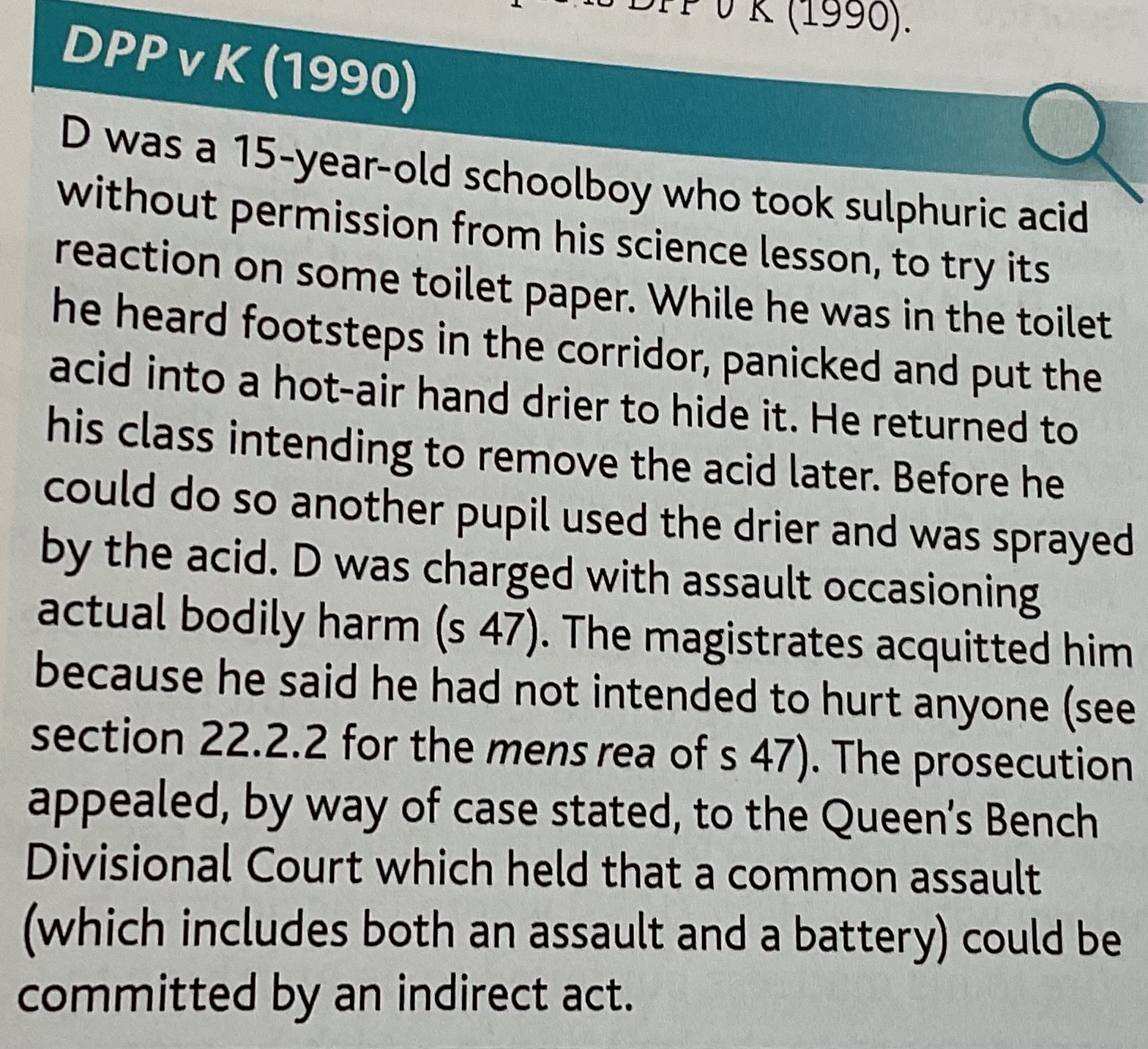
Haystead v Chief constable of Derbyshire 2000
D caused a small child to fall by punching the women holding the child. D was found guilty because he was reckless as to whether or not his actions would harm the child.
Principle of transferred malice
DPP V Santa Bermudez
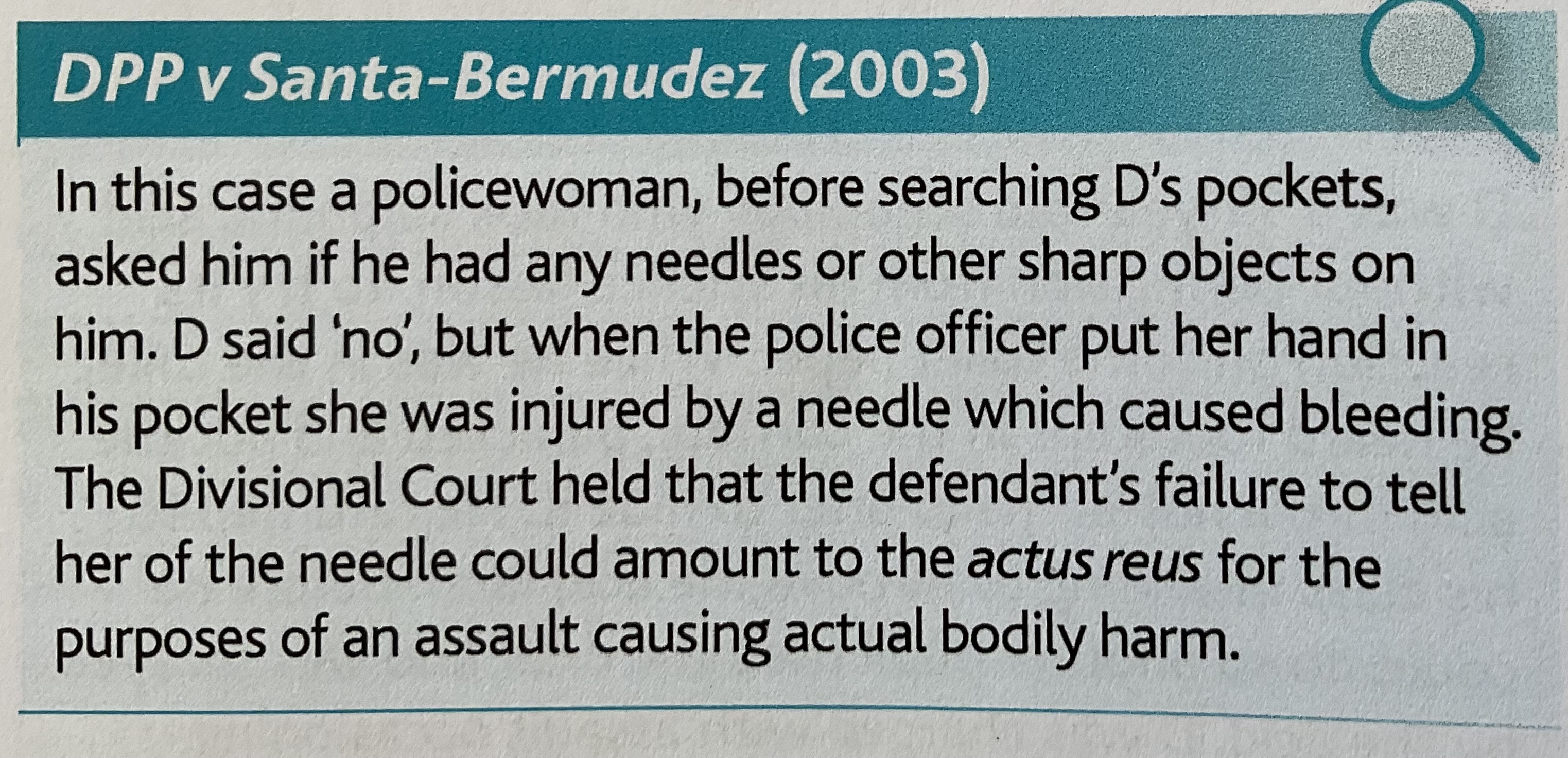
R v Miller
D accidentally set fire to his mattress but failed to do anything to prevent damage to building. Convicted of arson. No other person involved but if there had been someone there asleep in the room and miller had failed to warn them then he would have been liable for battery.
A v UK
Jury acquitted a father who had beaten his son with a garden cane. European court of human rights ruled that a law allowing force to be used on children offends article 3 of convention of human rights. Article forbids torture and inhuman or degrading treatment or punishment. However the children act 2004 now provides that a battery is committed if it results in injury.
Men’s Rea of asssault and battery
Assault- intention to cause another to fear immediate force or recklessness as to whether such fear is caused.
Battery-intention to apply unlawful force or recklessness
Both are basic internet offences so if d intoxicated they are considered to be acting recklessly
DPP v Majewski 1976
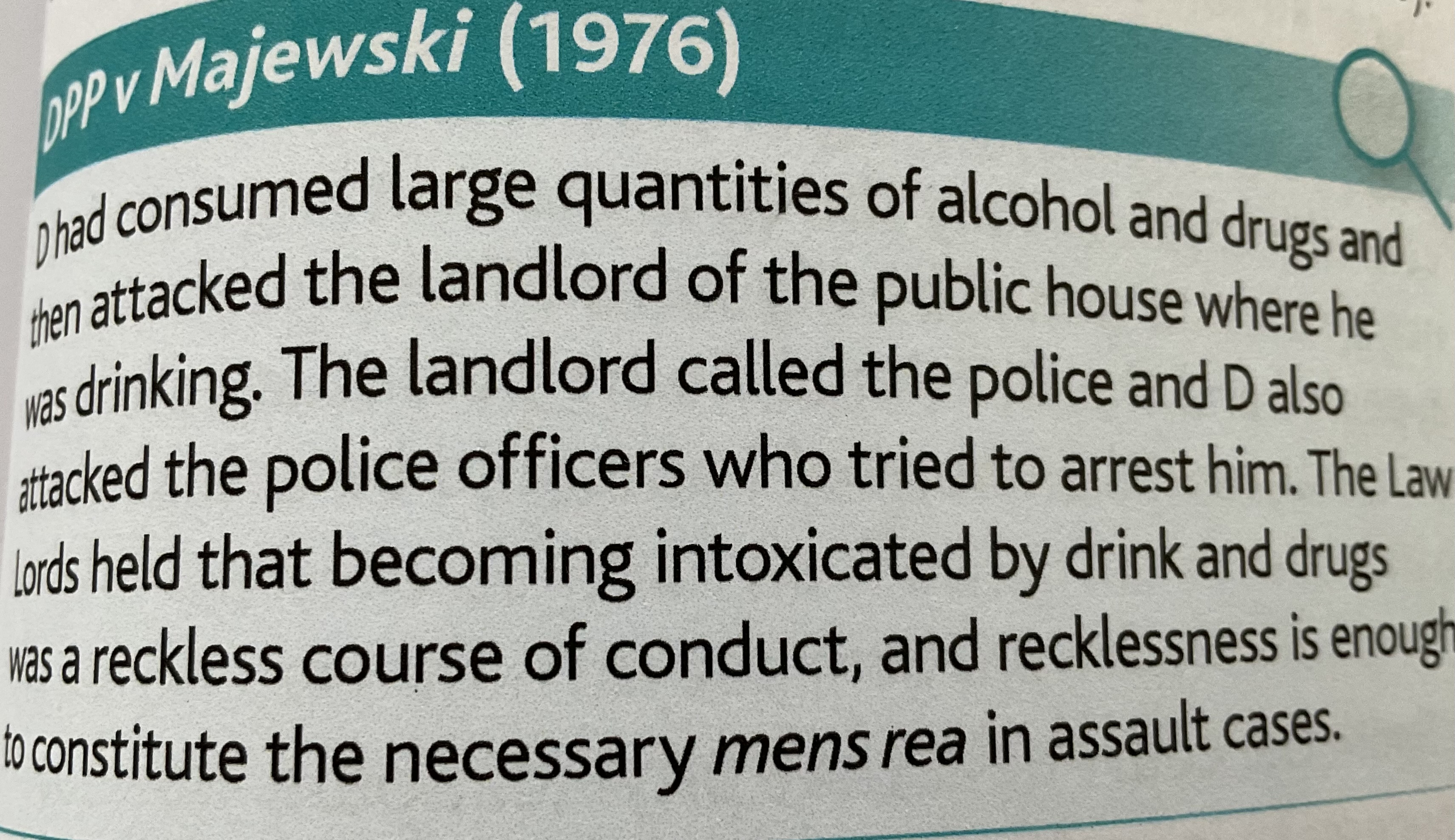
Section 47 OAPA 1861
Assault occasioning actual bodily harm
Triable either way offense- max 5 yrs in prison
Actus reus of sec 47
Must prove that actual bodily harm has occurred
ABH-any hurt or injury calculated to interfere with the health or comfort of the victim.
R v Chan Fook 1994
Trial judge directed jury that a nervous and hysterical state could be classed as actual bodily harm. Cora disagreed held that actual meant not so trivial as to be wholly insignificant.harm was injury that goes beyond the interpherance of health and comfort of the victim. Bodily is not limited to harm to skin. Includes injury to nervous system and brain and psychiatric harm.
R v Barstow 1997
Bodily harm must be interpreted to include recognisable psychiatric illnesses.
T v DPP

DPP v Smith
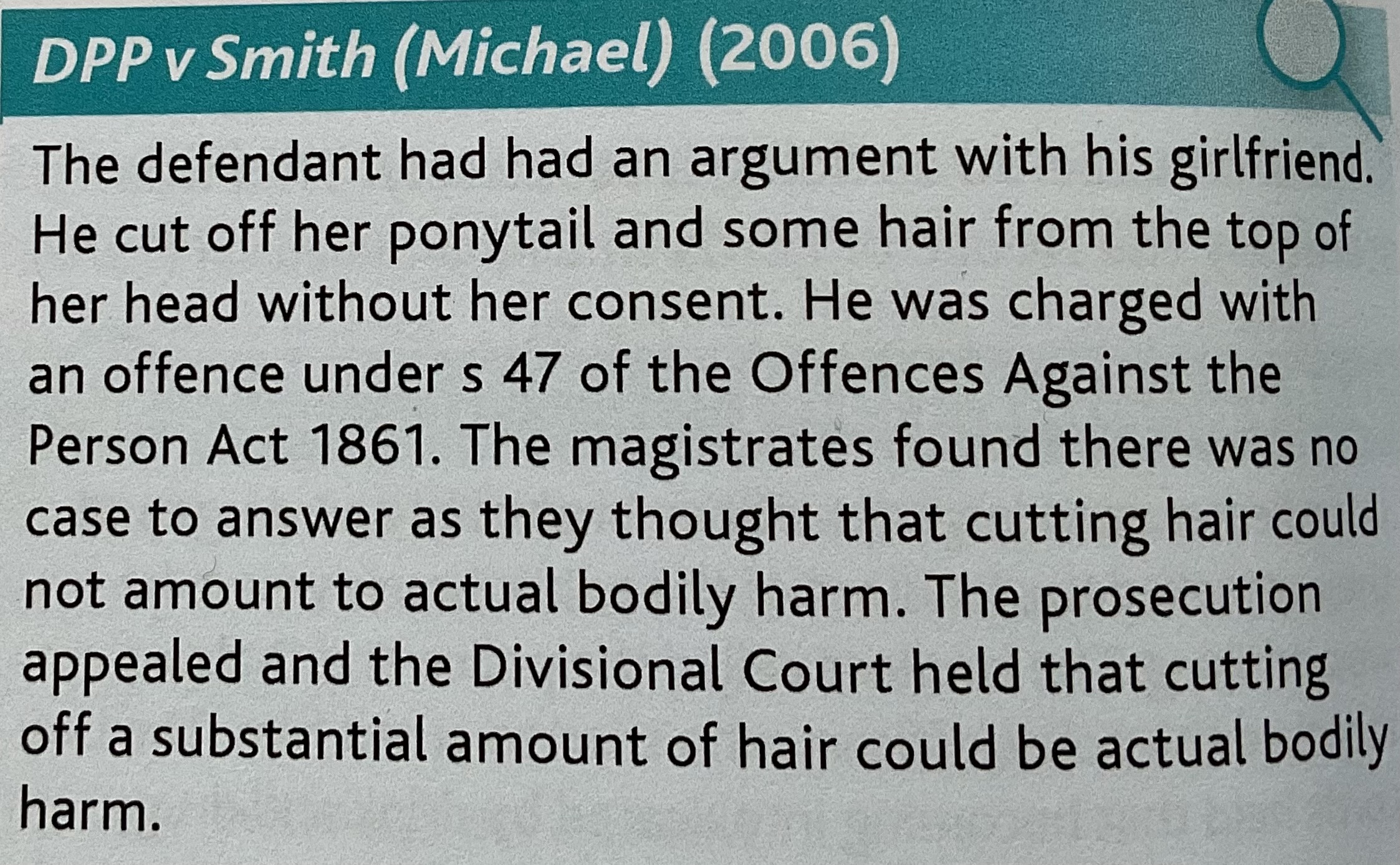
Men’s Rea of sec 47
Must intend or be subjectively reckless as to wether the v fears or is subjected to unlawful force.
R v Robert’s
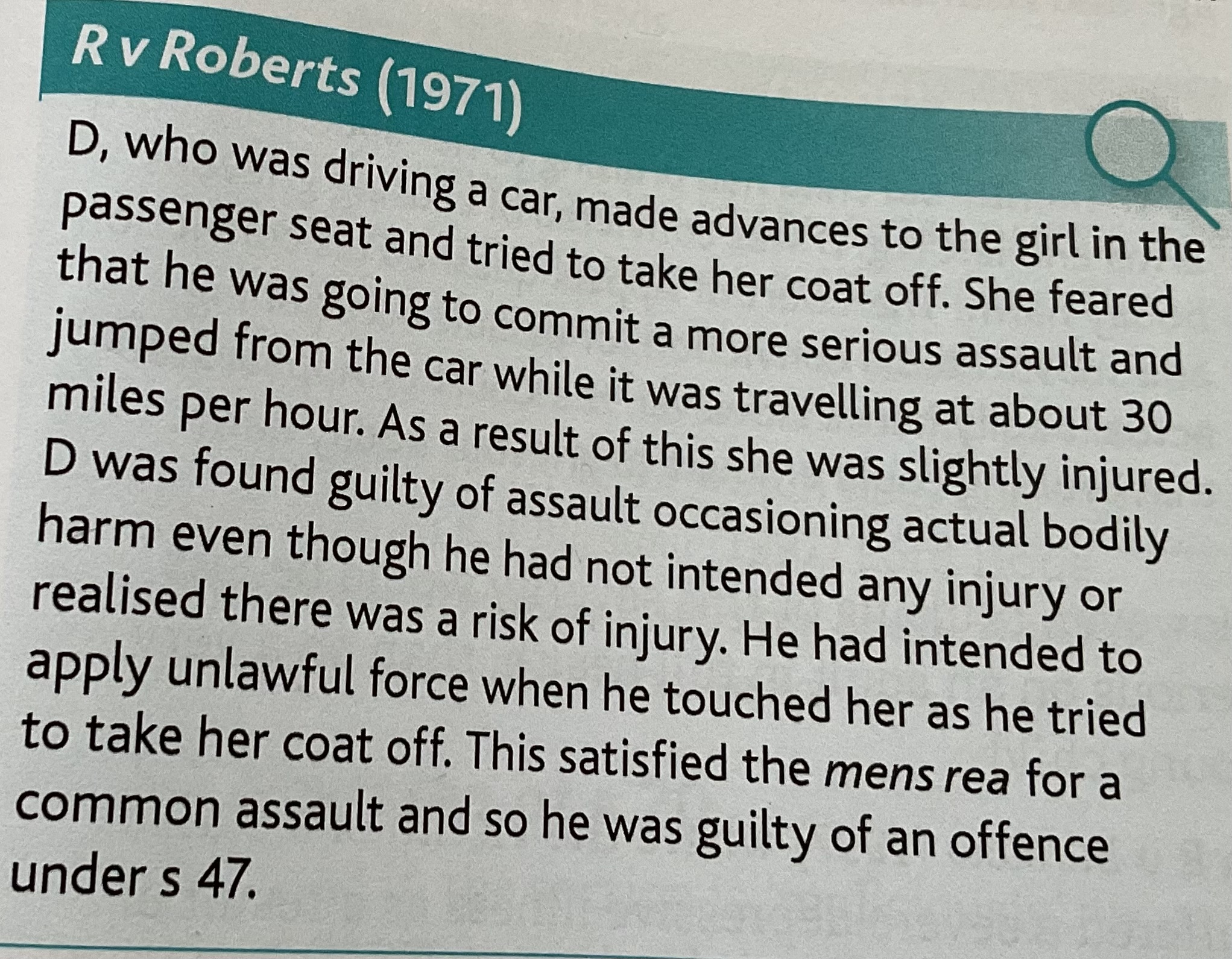
R v Savage 1991
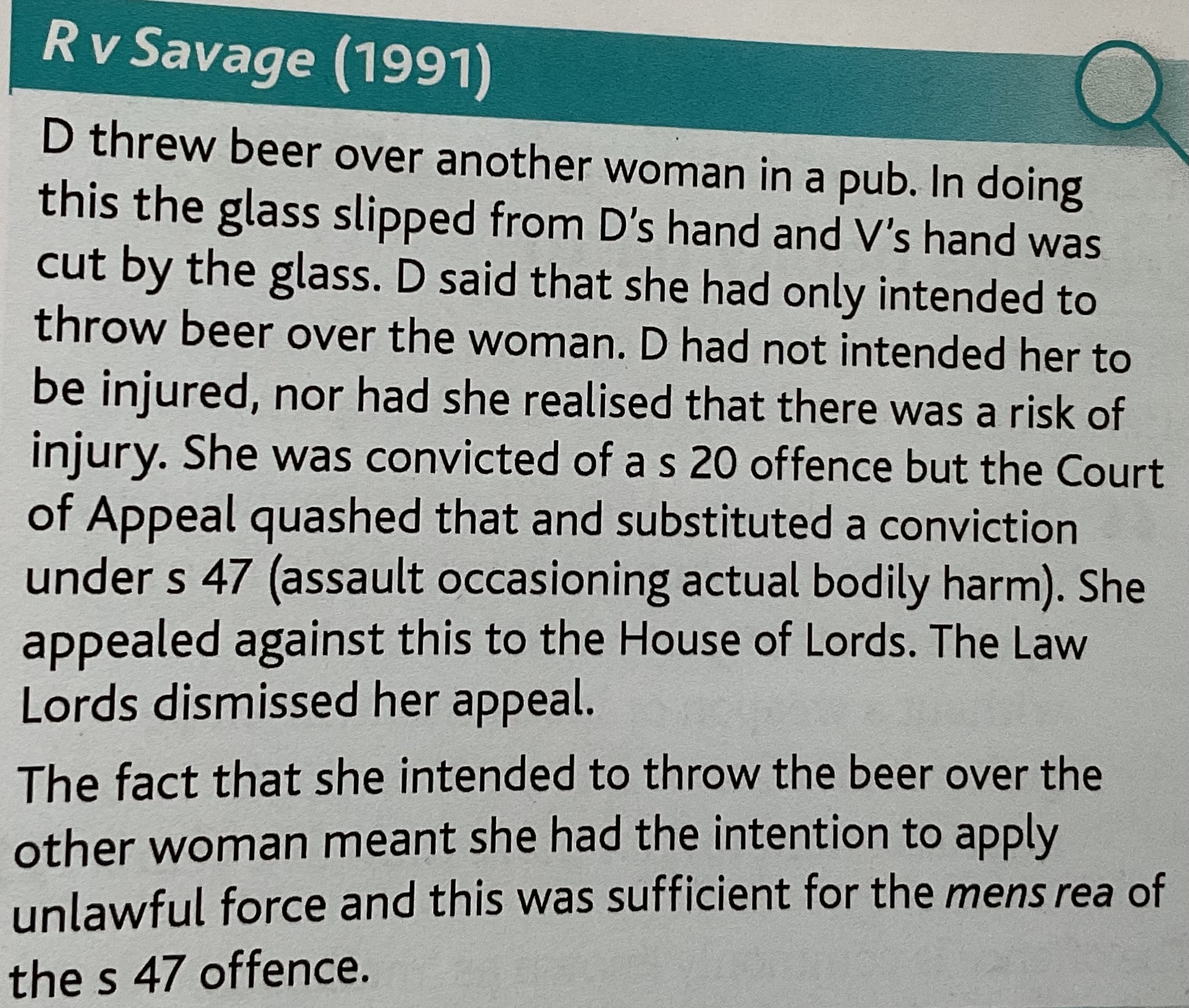
Assault occasioning actual bodily harm
An assault or battery which causes actual bodily harm to v and d intends or is subjectively reckless as to wether the v fears unlawful force or is actually subjected to unlawful force.
Section 20
Triable either way maximum 5yrs imprisonment
Must be shown that v is wounded or has grievous bodily harm. And that d intended some injury or was being reckless as to wether any injury was inflicted.
Wound
Cut or break in the continuity of the skin. Internal bleeding with no cut on the skin is not sufficient.
JCC v Eisenhower
V hit in the eye by a shotgun pellet but did not penetrate the eye, but did cause severe bleeding on the surface. As there was no cut held that not a wound
R v wood
V collar bone broken but did not pierce skin and so held that not a wound.
Grivious bodily harm DPP v smith
Held that it means really serious harm. Harm does not have to be life threatening.
Saunders
Held that it was permissible to direct a jury that there need be serious harm not including the word really.
R v Barstow
V of stalker suffered a severe depressive illness as a result and decided that serious psychiatric injury can be grievous harm.
R v Bolllom 2004
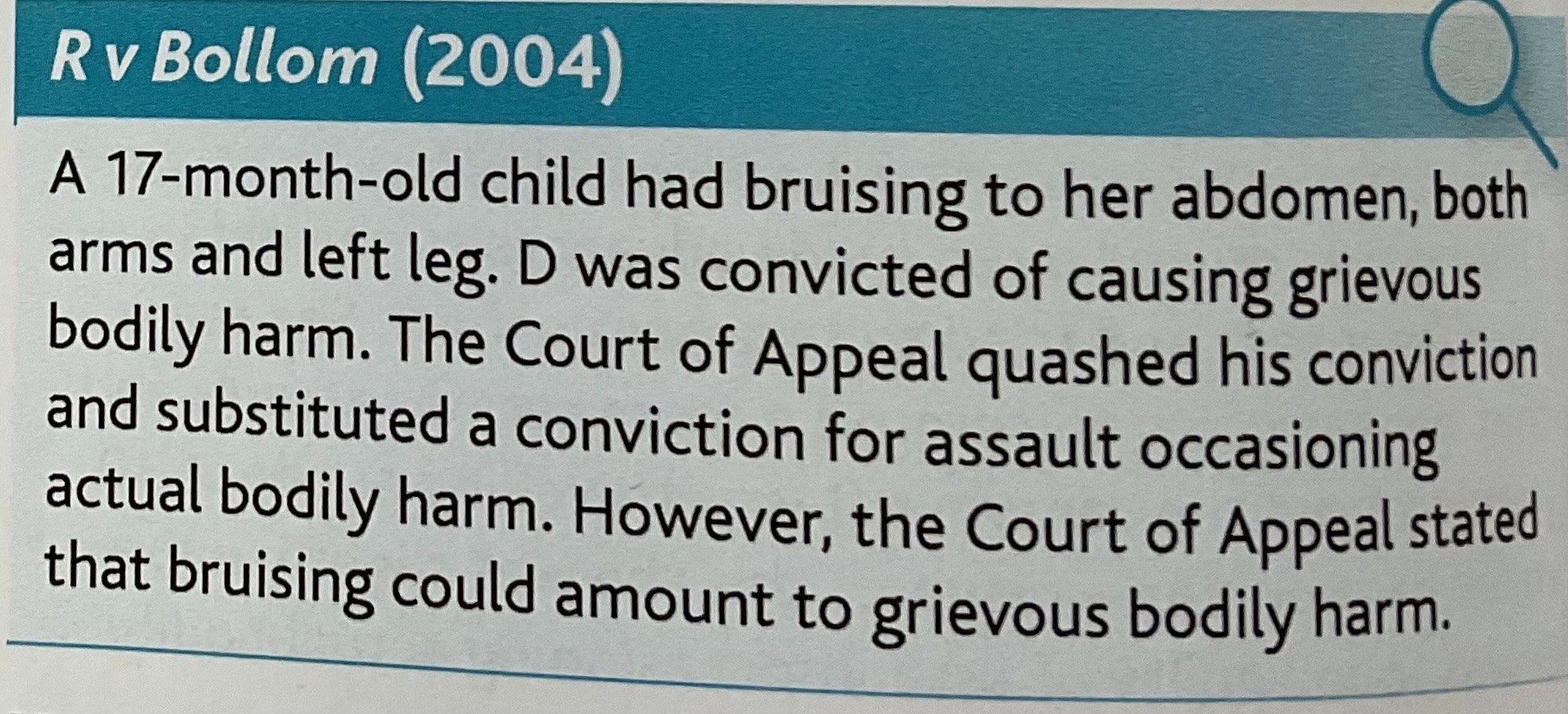
R v Dica 2004
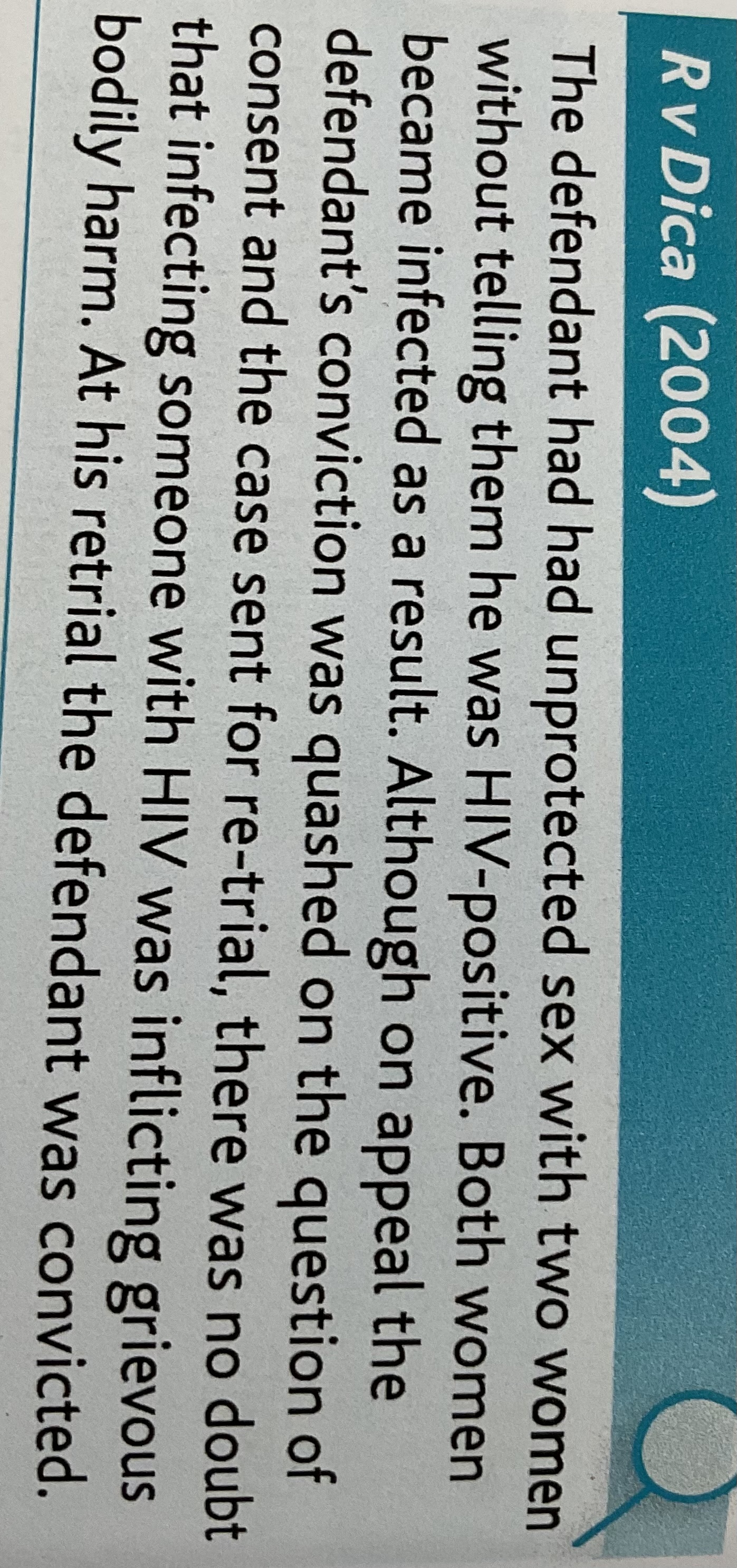
Inflicting GBH
Sec 20 uses word inflict. Originally taken as meaning had to be a technical assault or battery but allowed wide interpretation.
R v Lewis
D shouted threats at wife through a closed door in a 2d floor flat and tried to break through door. Wife was scared and jumped out window and broke both her legs. D convicted of s20 offence-could be considered technical assault.
R v Burstow
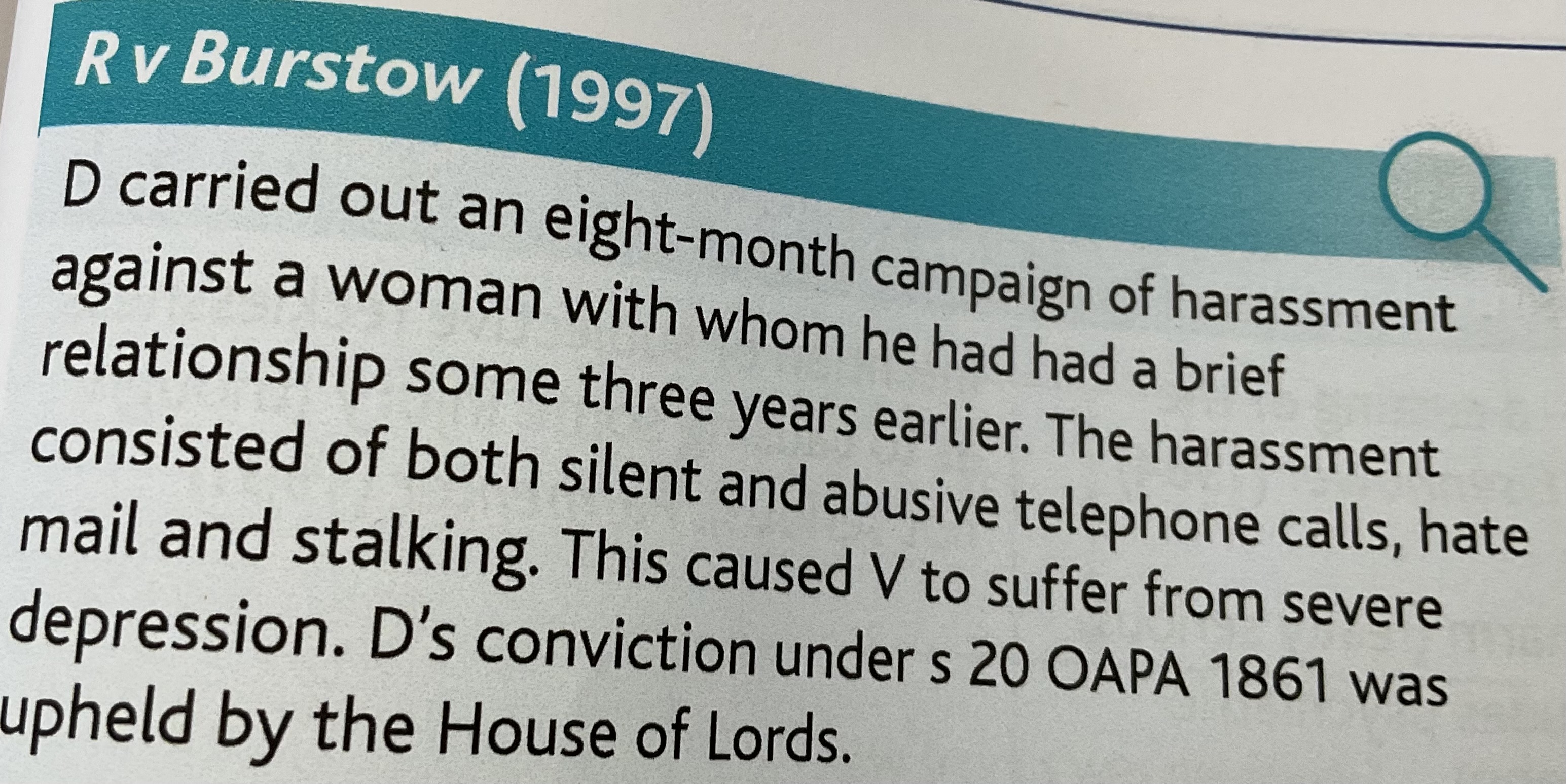
Need only show that’s d’s actions led to the consequence of the v suffering gbh. Lord hope said that for all practical purposes there was no difference between the words cause and inflict.
Men’s Rea s20
Maliciously-held in Cunningham that meant either an intention to do particular kind of harm that it was in fact done or recklessness as to wether such harm should occur or not.
R v Parmenter 1991
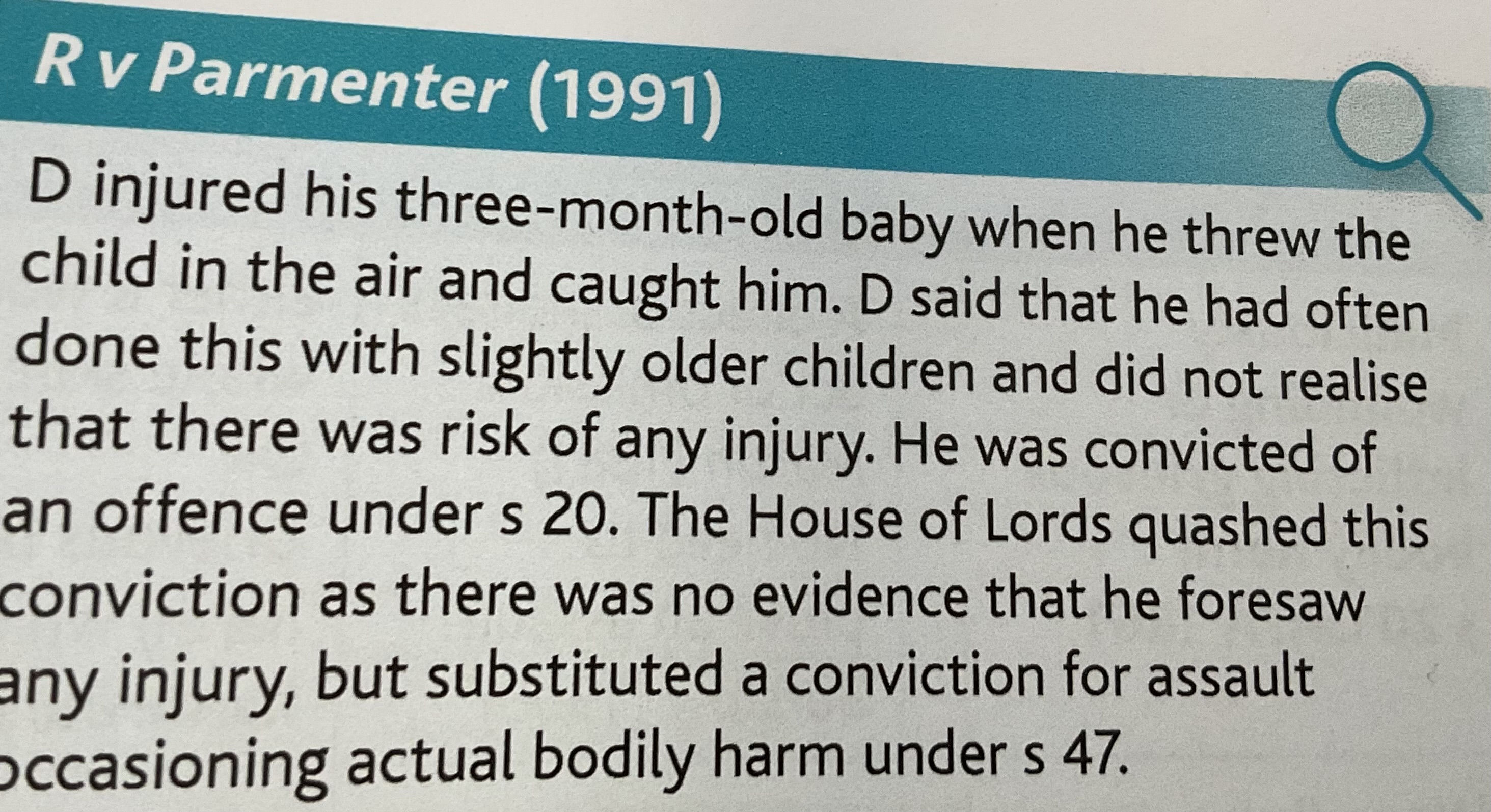
S18
Maximum sentence of life imprisonment must be tried on indictment at crown court.
Actus reus of s18
By wounding or causing grievous bodily harm.
Cause- need only prove that the d’s act was a substantial cause of the wound or gbh
Men’s Rea s18
Must have intended to do gbh or resist or prevent the lawful apprehension or detainer of any person.
Intending to do some gbh-for wounding must have specific intent. For resisting arrest the intention is lower. Prosecution must prove that had specific intent to prevent arrest but as far as injury then recklessness is sufficient.
R v Morrison
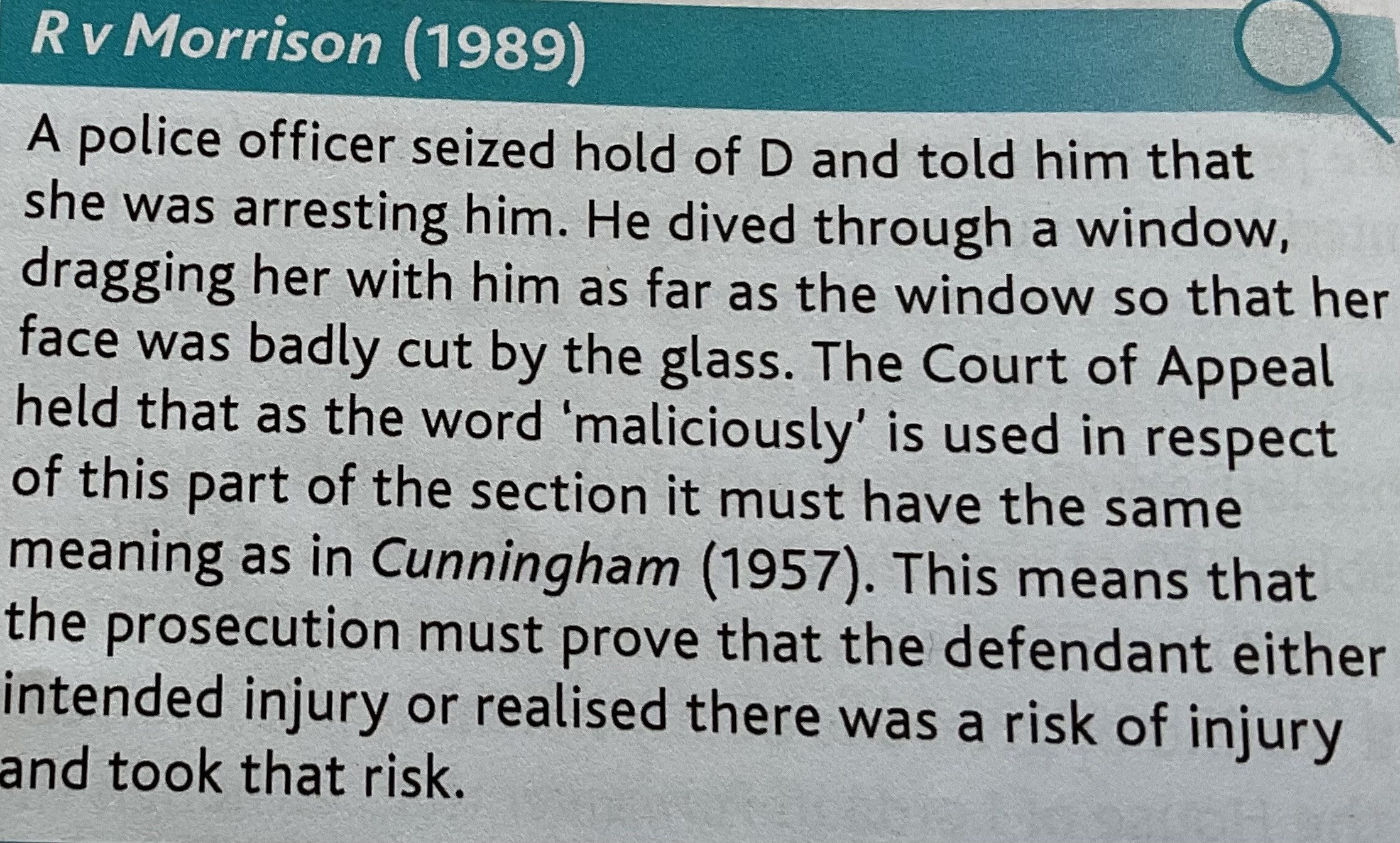
Reform- out of date
Back then didn’t understand mental health problems and so the statute only mentions bodily harm
Also problems as to whether inflicting bodily harm can be in line with infecting someone with a disease. Courts have filled this gap. Dica- held that infecting someone with hiv did come within the wording of inflicting gbh.
Reform-inconsistency between offences
S47 has the same men’s Rea as assault or battery but instead carries a 5yr imprisonment when battery is only 6 months.
Also unjust that a person who causes a small cut can be charged with a more serious sec 20 just bc classed as a wound.
Also maximum sentence for 47 and 20 are the same but s20 is a more serious offence.
There is no hierarchy of offences
Is it right that someone who resists arrrest can be liable for same offence as someone who causes gbh.
Correspondence principle-d must intend or foresee the results that actually occur and should not be held liable for na given kind of harm if they did not mean it. But under the act a d can be guilty under s20 without intending or being reckless as to causing serious harm.
Reform-need for modern simplified language
S20 uses the word maliciously. Modern lang suggests that the d is acting deliberately with ill will to v. But m,ending of act has been held that d either intended to do the type of har, that was done or reckless as to whether harm occurred.
Not consistent- s20 word inflict is used s18 cause.
1998 draft bill
Clause 1-intentional serious injury
Clause 2- reckless serious in jury
Clause 3-intentional or reckless injury.
Clause 4-assault a person would be guilty if he or she intentionally or recklessly applied force to or caused an impact on the body of another or caused the other to believe that any such force is imminent.
In each clause level of injury and required men’s Rea are made clear. And injury defined as physical and mental
Law commission report 2015
Recommended that there should be a clear hierarchy of offences, each offence should provide a clear and accurate label for conduct in easy to understand language also each ingredient of an offence should be set out explicitly.
Clause 1-most serious wounding not used so only wounds included if very serious-maximum life imprisonment
Clause 2-normal principles of recklessness apply- 7yrs imprisonment replaces sec 20
Clause 3-replace s47 max 5yrs imprisonment. Meant intention or recklessness
Alos recommended that there be an offence for low level injuries- aggravated assault max 12 months imprisonment
Recommends that there should also be an offence of physical assault instead of battery -max 6 months
Recommends threatened assault would replace common law offence of assault but cover same things
Proposed separate offence for resisting offence